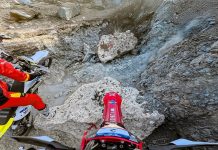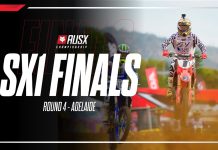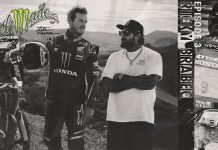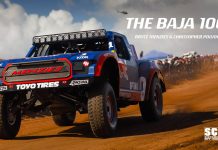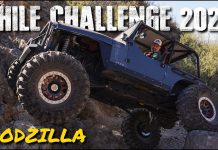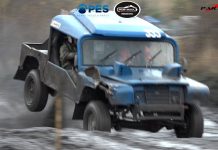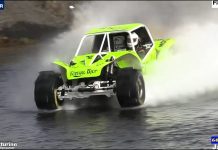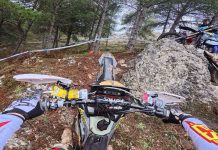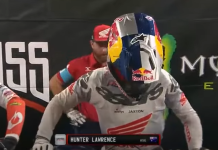Jetzt geht’s ans Eingemachte und der T7 wird auf dem Prüfstand alles abverlangt. Außerdem wird der erste Prototypen-Rohling hergestellt.
Bevor wir ins Detail des Leistungs-Updates gehen noch ein paar Vorabinfos auf die kommenden Anbauteile und Maßnahmen für die weitere sinnvolle Modifikation der T7. Denn obwohl die zuletzt vollzogene Fahrwerks-Abstimmung in Verbindung mit der neuen Bereifung Michelin Anakee Wild einiges mehr an Leistungsfähigkeit Offroad gebracht hat ist hier noch ordentlich Luft nach oben.
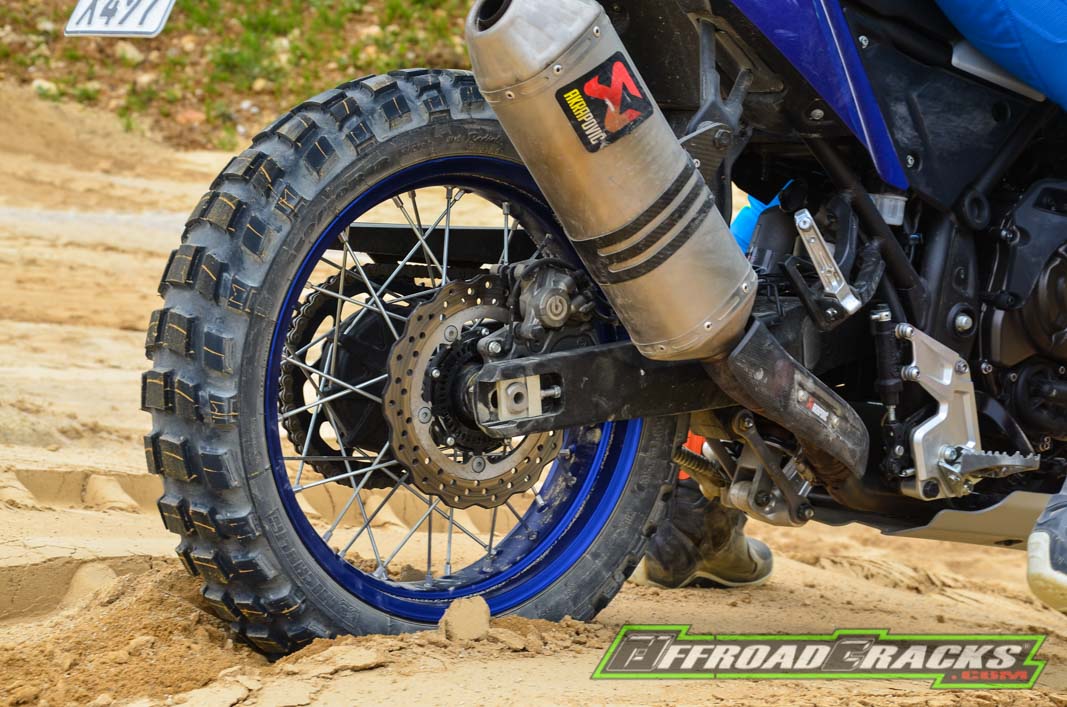
Die Michelin Anakee Bereifung sorgt gegenüber der Serien-Lösung für ordentlich Schub im Gelände
Gleichzeitig müssen wir aber auch für die notwendige Sicherheit im Fahrbetrieb sorgen, was zugleich auch mit einem verbesserten Schutz des Fahrzeugs einhergeht. Denn bekanntlich bringt Speed auch stärkere Einflüsse mit sich, die sich beispielsweise durch höhere Ein- und Ausfedergeschwindigkeit bei den Federelementen wiederspiegelt, was wir wie bereits bekannt durch das Technical-Touch-Fahrwerks-Setup zielführend kompensiert haben – Dauertest Teil 2 LINK.
Jedoch bleibt noch ein wichtiger Punkt offen und zwar der Federweg. Denn der entspricht bei der T7 mit 210 Millimeter vorn und 200 hinten zwar den weitgehend üblichen Adventure-Bike Werten, aber für die härter Gangart mit ordentlich Speed verlangt es bei einem Kampfgewicht von 200 Kilogramm für mehr Sicherheit einfach nach mehr.
Im Detail bedeutet das, dass die bisherige Abstimmung zwar einen guten Kompromiss aus Komfort und Durchschlagssicherheit darstellt, aber bei höheren Fahrwerksanforderungen wie beispielsweise Sprüngen oder Überfahren von mehreren hintereinander folgenden Wellen zu früh an seine Grenzen kommt. Das heißt: Mit dem bisherigen Fahrwerks-Komponenten müssten man zur hundertprozentigen Schonung des Materials die Dämpfung auf das Maximum einstellen. Das wiederum offenbart im Einsatz ein sehr langsam agierendes unsensibles Fahrwerk mit vergleichsweise sehr geringen Ein- und Ausfedergeschwindigkeiten, um ein Durchschlagen beziehungsweise das überbeanspruchen des Materials zu verhindern.
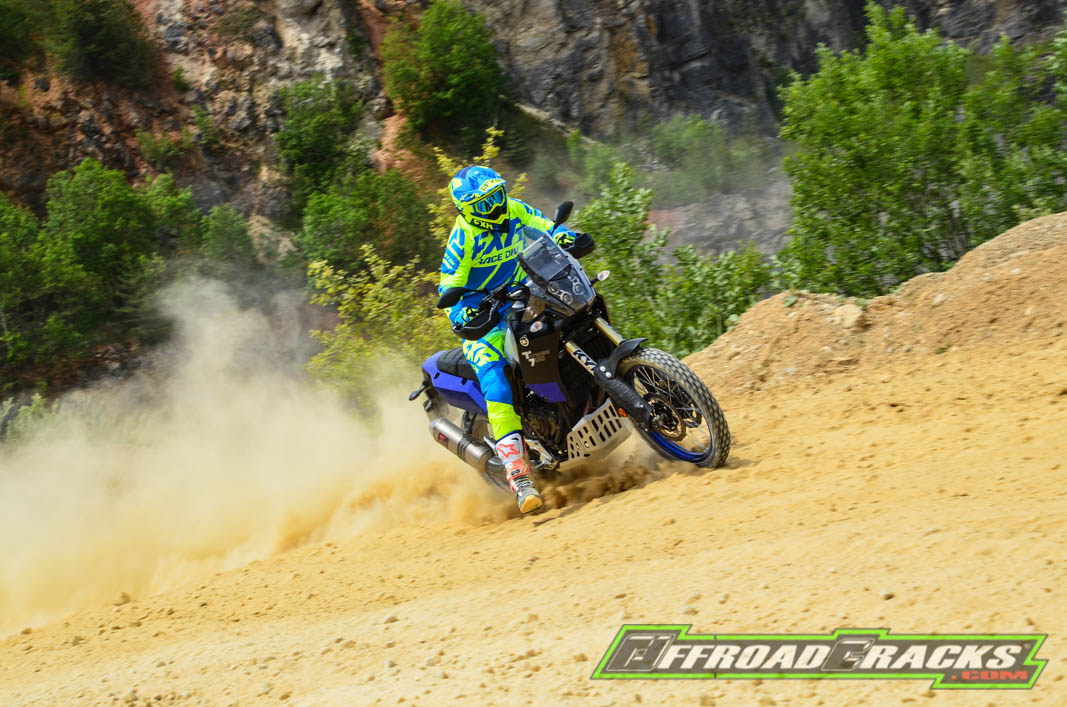
Keine Frage, die bisher gezeigten T7-Sprungeinlagen von Kollegen und Spitzenpiloten in den Sozialen Medien oder auf Youtube sind zwar actionreich und schön anzuschauchen, überfordern aber bei dieser Gangart definitiv die Federelemente samt Material, so dass ein früher und extrem hoher Materialverschleiß bis hin zum möglichen Defekt vorprogrammiert ist.
Folgendes Anschauungsbeispiel in Zeitlupe: Wir fahren mit der T7 über mehrere 30 Zentimeter hohe Wellen und der Dämpfer federt mit dem Schlag der ersten Welle ein während schon der nächste Schlag von der zweiten Welle herrührt und den Dämpfer noch weiter einfedern lässt und so weiter. Irgendwann erreich man einen Punkt, an dem das Federbein keinen Federweg mehr zu Verfügung hat, da die aufeinanderfolgenden Wellen dem vergleichsweise überdämpften Dämpfer – Kompromiss zur Erhöhung der Durchschlagssicherheit – keine Zeit zum Ausfedern geben. Denn die Ausfedergeschwindigkeit wurde ja maximal gedämpft, also verlangsamt. Das heißt der von Welle zu Welle verfügbare Federweg oder Hub wird immer geringer bis man an den Punkt gelangt, bei dem die volle Auftreffenergie der nächsten Welle auf den komplett eingefederten Dämpfer trifft. Was passiert also, so wie es uns mit der AJP PR7 2018 bei der Rallye-Breslau ergangen ist. Die Energie kann nicht in die Einfederbewegung des Dämpfer aufgenommen werden, sondern wird bei voll eingefederten Federbein ungefiltert an das Fahrzeug weitergegeben, so dass das Heck oder auch am Beispiel der Gabel hochschlägt, der Bodenkontakt verloren geht und keine Fahrzeugkontrolle mehr möglich ist. Dieser Ablauf führt meist im Rallye-Einsatz unter hohem Tempo dazu, dass das Heck einmal von links nach rechts versetzt ausschlägt, und zu guter Letzt einen klassischen Highsider fabriziert und den Fahrer abwirft.
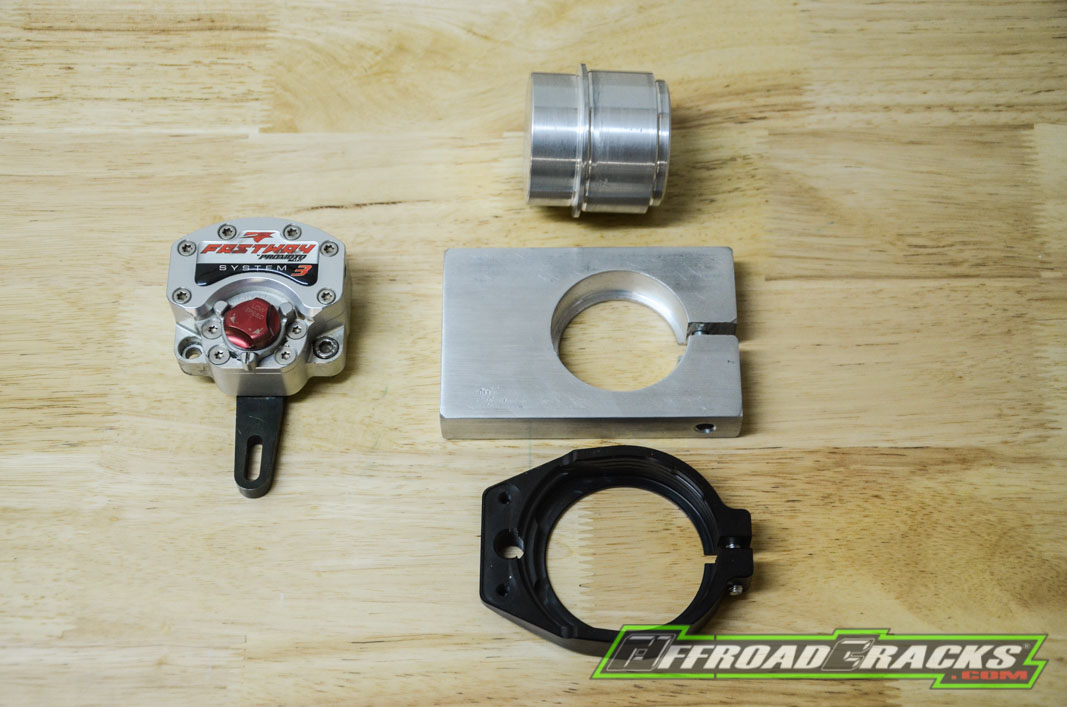
Lenkungsdämpfer- Prototyp-Halterung zur Anwendung am T7-Steuerkopf
Dieses Wissen und die damit schon gemachten Erfahrungen eines „überfahrenen Fahrwerks“ führt uns dazu Federelemente mit mehr Hub zu verbauen, was wir mit einer 48er Kayaba-Gabel einer Yamaha YZ450F umsetzen werden. Dafür wurde für uns von dem renommierten Hersteller Xtrig ein Rocs-Gabelbrücke-Kit für diese Gabel mit neu entworfenem Steuerrohr entwickelt, das den Einsatz der 48er Cross-Gabel mit um die 300 Millimeter Hub zulässt. Natürlich wird auch diese Gabel ein entsprechendes Setup erhalten.
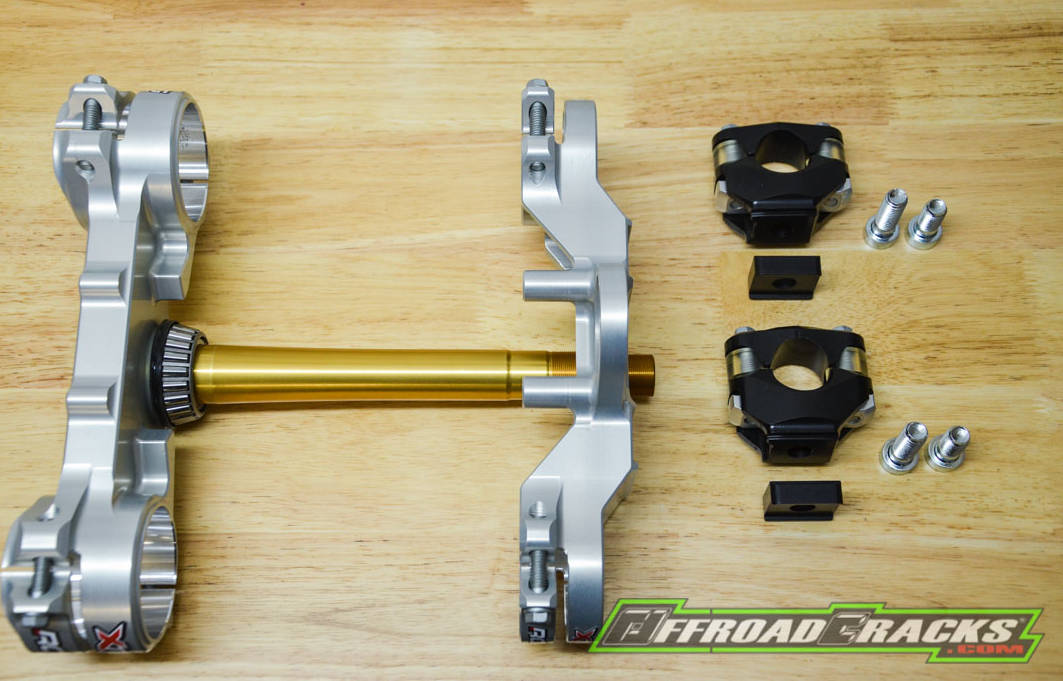
Xtrig-Gabelbrücken-Kit Sonderanfertigung mit passendem Steuerrohr samt Lager und PHDS-Lenkeraufnahmen
Fürs Federbein gestaltet sich eine ähnliche Maßnahme deutlich schwieriger, da hier zahlreiche geometrische Aspekte und auch das notwendige und realisierbare Platzangebot berücksichtigt werden müssen – dazu in den nächsten Zwischenberichten mehr.
Hoher Speed birgt wegen höherer und länger anhaltende Belastungsspitzen fürs Material und diverse Bauteilen auf Dauer erhebliche Gefahren. Deshalb ist die erste wichtige Maßnahme ein solider und wirksamer Motorschutz, der zugleich auch die Hebelumlenkung sowie die Anbauteile wie Wasserpumpe, Seitenständer-Sensor oder das Motorgehäuse sowie die Unterzüge schützt. Hier setzen wir auf ein bewährtes Produkt des Herstellers AXP-Racing, das aus acht Millimeter starken HDPE, ausgeschrieben High Density Polyethylen und zu deutsch Polyethylen mit hoher Dichte, gefertigt wird.
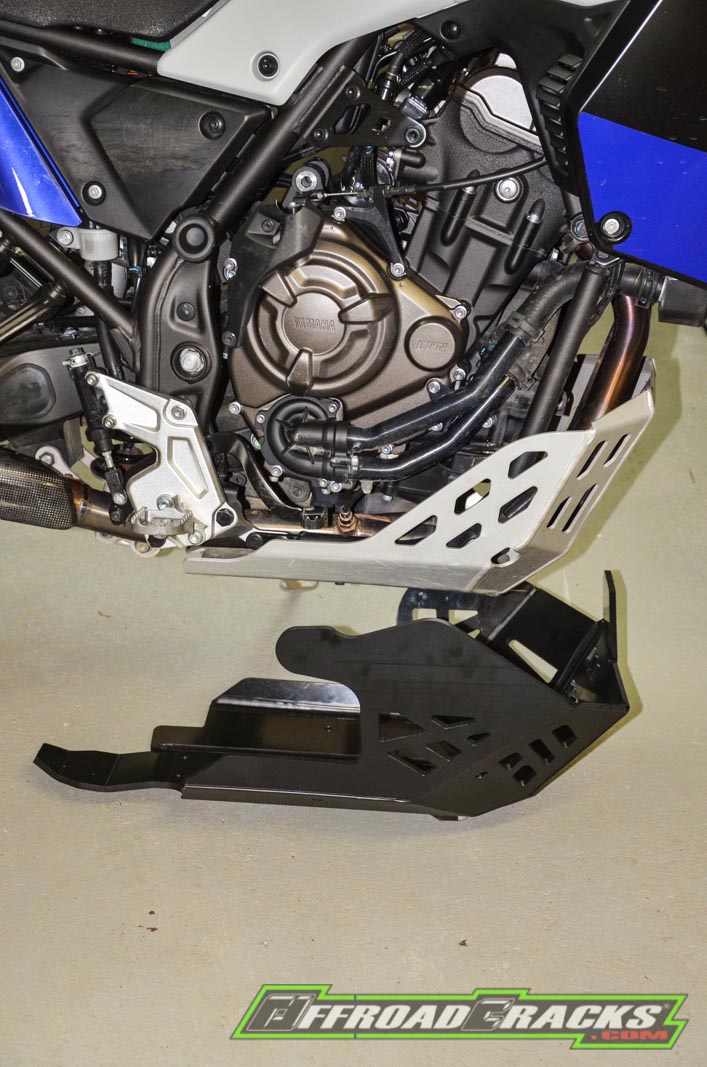
Maximale Protektion dank flexiblem HDPE-Motorschutz von AXP-Racing aus Frankreich
Nun zum Leistungsupdate: Hierfür haben wir diverse Konfigurationen auf dem Prüfstand abgefahren, um die jeweiligen Ergebnisse und deren wirklichen Mehrwert feststellen zu können. Das heißt im Detail folgende Zustände: Original-Fahrzeug, kurz OEM, dann mit Akrapovic-Slip-On-Schalldämpfer und zuletzt mit einer kompletten Akrapovic-Auspuffanlage. Dazu kommt eine OEM Airbox, der Micronsystems-Luftfilterkit, ein TwinAir-Vorserien-Luftfilterkit, was nochmals durch eine geflashte ECU unterteilt wird. Damit ergeben sich zahlreiche Möglichkeiten, deren Auflistung samt Leistungsverläufe im Diagramm nur Verwirrung stiften würde. Für uns intern waren zudem die Unterschiede wichtig zwischen 20 Prozent geöffneter Drosselklappe, 40 Prozent und bei 100 Prozent, also unter Volllast.
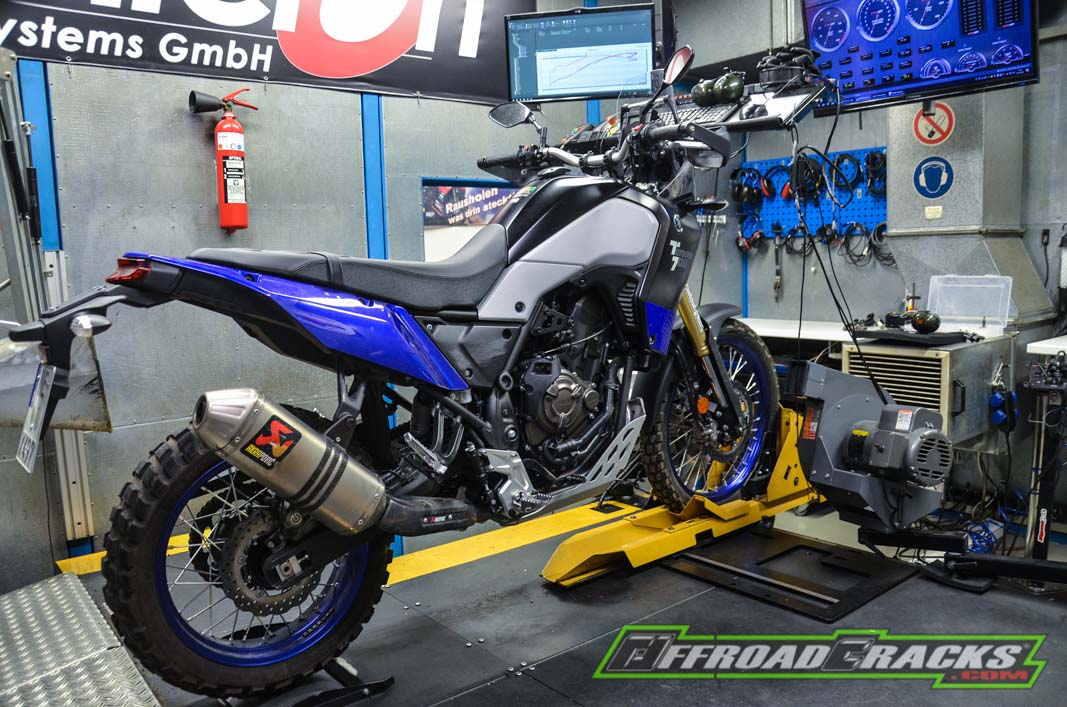
Wir haben hier nur die wichtigsten und herausragendsten Ergebnisse im Diagramm dargestellt, um einen Überblick zu behalten. Wir erinnern uns, dass die Eingangs-Messung Anfang des Jahres unsere T7 73,54 PS bei 9.011/min und 67,76 Newtonmeter bei 6.489/min ergeben hat. Vornweg sei gesagt, dass wir einen maximalen Leistungszuwachs von zehn Prozent erzielen konnten, der sich aber nicht unter Volllast, also bei einer Drosselklappenstellung von 100 Prozent abspielt, sondern im Teillastbereich bei beispielsweise 40 oder 60 Prozent. Also genau dort, wo man auch Leistung benötigt. Denn niemand ist ununterbrochen mit Volllast unterwegs, schon gar nicht im Gelände. Das kann man eigentlich nur auf der Autobahn exerzieren.
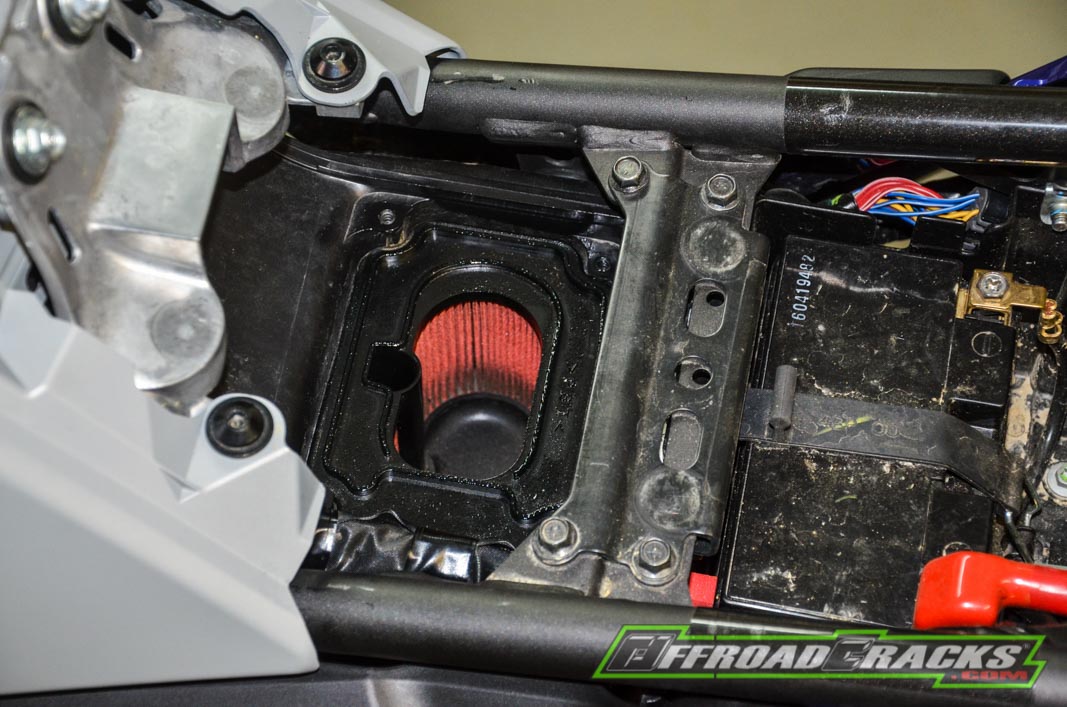
OEM-Papier-Luftfilter der Yamaha Ténéré 700 mit demontierten Ansaugstutzen
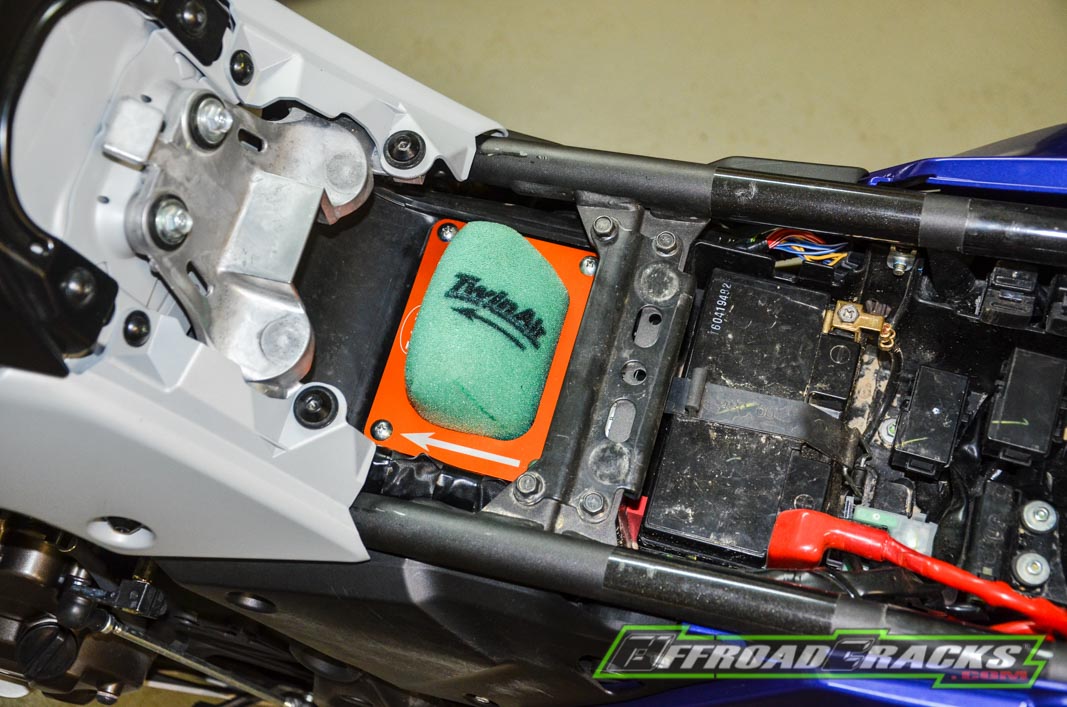
Montierter TwinAir-Luftfilter-Kit als ideale Offroad-Lösung
Wir picken uns hier die drei wichtigsten Konfigurationen heraus. Das wäre zum einen nur der Akrapovic-Slip-On Schalldämpfer und zum anderen der Akrapovic-Slip-On Schalldämpfer mit Micronsystems-Luftfiltersystem und geflashter ECU und zu guter Letzt die Akrapovic-Komplettanlage mit TwinAir-Luftfilter-Kit und geflashter ECU. Letztere hat einen hoch tauglichen Offroad-Luftfilteraufsatz montiert, der für uns am idealsten für das angedachte Einsatzgebiet erscheint. Die Original-Leistungskurve in der Farbe Blau erreicht aktuell nicht ganz den Spitzenwert der Eingangsmessung vom Anfang des Jahres, da die Bedingungen im Vergleich dazu aktuell deutlich wärmer waren und der Sauerstoffgehalt in der Luft am Prüfstand geringer ausfiel.
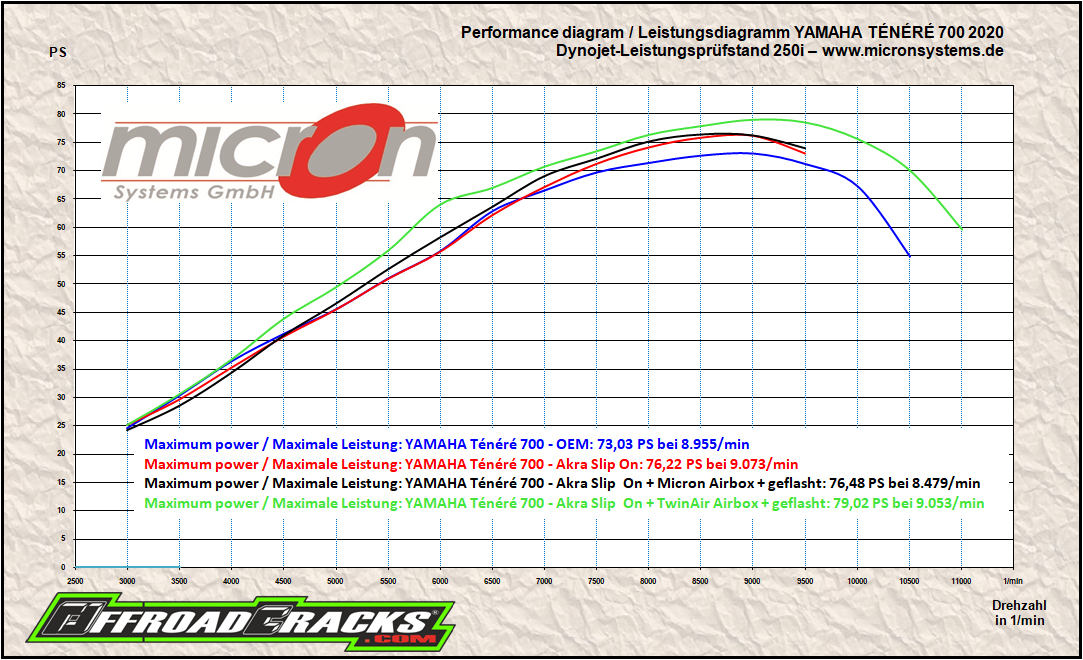
Zu den Ergebnissen: Der Akrapovic-Slip-On Schalldämpfer legt um etwas mehr als drei PS im Vergleich zu OEM-Ausführung zu, während die gleiche Variante mit abgeänderter Micronsystems-Airbox und geflashter ECU vor allem in der Mitte zwischen 4.500 und 8.500/min um teilweise bis zu drei PS nachlegt und im Teillastberich alles toppt. Die wohl größte Ausbeute unter Volllast – wie nicht anders zu erwarten war – stellt die Konfiguration mit der Akrapovic-Komplett-Anlage, dem TwinAir-Filterkit und der geflashten ECU dar. Hier knackt man die 79 PS Marke. Das sind gegenüber dem Standard-Fahrzeug knapp sechs PS mehr an Höchstleistung. Aber auch hier ist mal wieder entscheidend was dazwischen und vor allem im Teillast-Bereich passiert, denn dort sind die größten Leistungsunterschiede festzustellen, so dass der Antritt aus einzelnen Fahrsituationen noch spontaner ausfällt. Damit klettert das Leistungsgewicht dank Akrapovic-Komplettanlage, die übrigens das Stargewicht auf 197,4 Kilogramm drückt, auf 2,49 PS/kg – im Original-Zustand waren es 2,76 PS/kg.
In den kommenden Wochen geht es an den intensiven Umbau auf Wettbewerbsrädern, Einscheiben-Bremsanlage und so weiter – es bleibt also spannend.

Vergleich: Offener OEM-Ansaugstutze links und TwinAir-Luftfilter-Kit mit geöltem Schaumstoff rechts
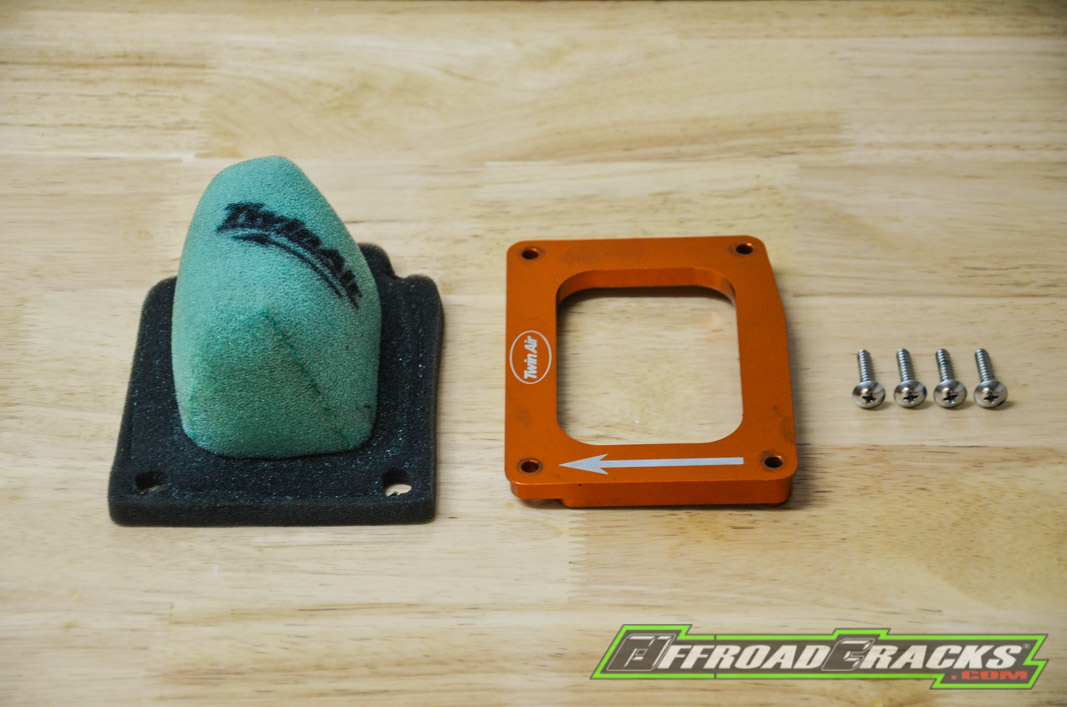

TwinAir-Offroad-Lösung als Ersatz für den Original-Ansaugstutzen und Erhöhung des Filtergrads
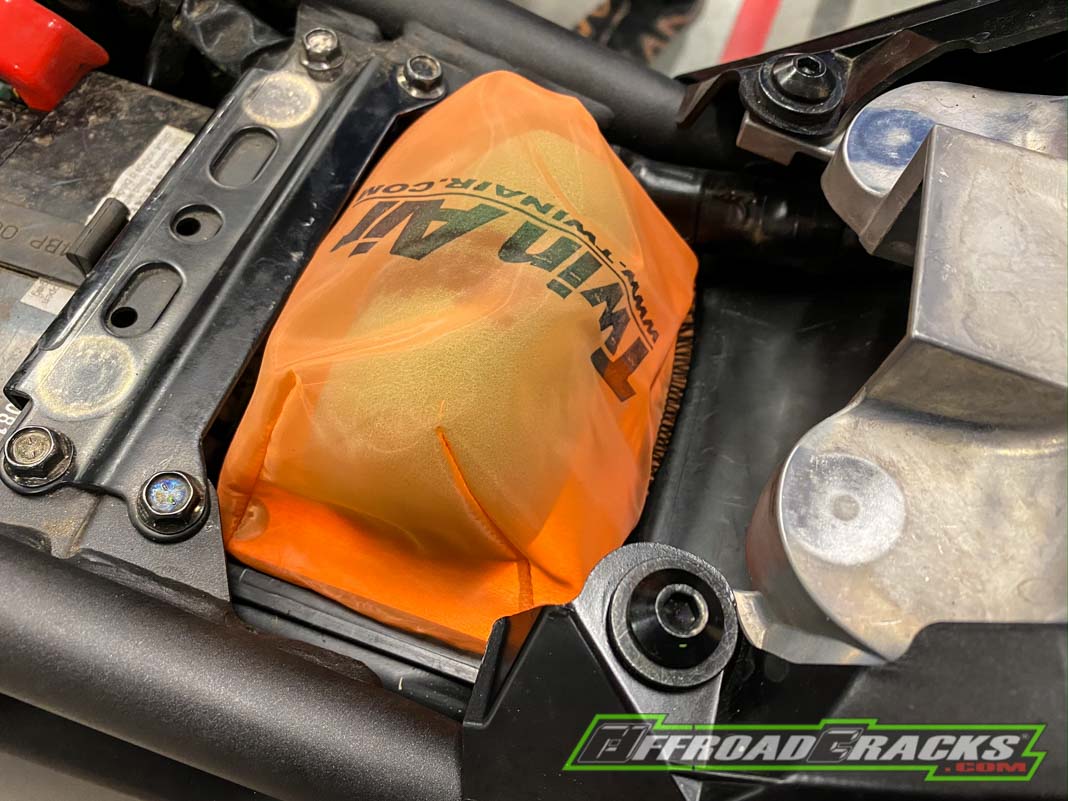
TwinAir-Lösung mit mit zusätzlicher GP-Abdeckung
Kooperationspartner
• www.akrapovic.com
• www.axpracing.com
• www.elfmoto.de
• www.fxrracing.com
• www.micronsystems.de
• www.promotobillet.com
• www.twinair.com
• www.xtrig.com
• www.yamaha-motor.eu/de
• www.zupin-shop.de
Montiertes Zubehör
- Luftfilter-Kit vorgeölt, TwinAir 124,12 Euro
- Ersatzfilter ungeölt, TwinAir 17,40 Euro
- Grand Prix Abdeckung, TwinAir Preis auf Anfrage
- Gabelbrückenkit T7 Sonderanfertigung, Xtrig
- PHDS Lenkerdämpfungssystem, Xtrig/Zupin 150,12 Euro
- Kunststoff-Motorschutz inkl. Umlenkung, AXP-Racing 239 Euro
- Fastway Lenkungsdämpfer, Promotobillet 399 Euro
- Lenkungsdämpfer-Aufnahme Sonderanfertigung S. Christof
- Lenkungsdämpfer-Gegenlager Sonderanfertigung S. Christof
- Powervision 3, Micronsystems 429 Euro
- „In House“ Lizenz ohne Powervision 3 als kostengünstige Alternative, Micronsystems 199 Euro
- Einmalige Leistungsmessung, Micronsystems 59 Euro
- Flashen (Prüfstandabstimmung mit Eingangs- und Abschlussmessung, Micronsystems 398 Euro
Wartung
- 1x Moto Kettenspray 400ml, Elf Moto
- 1x Moto Organic Kühlwasser, Elf Moto
![]()
Now it’s down to the nitty-gritty and everything is demanded of the T7 on the test bench. In addition, the first prototype blank is produced.
Before we go into the details of the performance update, a few preliminary information on the upcoming add-on parts and measures for the further useful modification of the T7. Because although the recently completed chassis tuning in connection with the new Michelin Anakee Wild tires has brought a lot more off-road performance, there is still plenty of room for improvement.

The Michelin Anakee tires provide a lot of thrust off-road compared to the standard solution
At the same time, however, we also have to ensure the necessary safety when driving, which also goes hand in hand with improved vehicle protection. Because, as is well known, speed also has stronger influences, which are reflected, for example, in the higher compression and rebound speed of the spring elements, which, as already known, we have compensated with the technical touch setup – long term test part 2 LINK.
However, one more important point remains open and that is the suspension travel. Because with 210 millimeters at the front and 200 at the rear, this corresponds to the largely usual adventure bike values, but for the harder pace with a lot of speed, with a combat weight of 200 kilograms, more safety is required.
In detail, this means that although the previous set-up represents a good compromise between comfort and bottom out resistance, but it reaches its limits too early in the case of higher suspension requirements such as jumps or driving over several successive waves. This means: With the previous suspension components, you would have to set the damping to the maximum to protect the material one hundred percent. This in turn reveals a very slowly acting, insensitive suspension with comparatively very low compression and rebound speeds in order to prevent bottom out or overstressing of the material.

No question, the T7 jumps shown so far by colleagues and top pilots in the social media or on YouTube are action-packed and beautiful to look at, but definitely overwhelm the suspension elements and material at this pace. Result: An earliy defect is preprogrammend because of the extremely high material wear and tear.
The following illustrative example in slow motion: We drive the T7 over several 30 centimeter high waves and the damper compresses with the impact of the first wave while the next impact comes from the second wave and allows the damper to compress even further and so on. At some point you will reach a status where the shock absorber has no more travel available, as the successive waves do not give the comparatively overdamped damper – a compromise to increase the breakdown safety – no time to rebound. Because the rebound speed was dampened to the maximum, i.e. slowed down. This means that the spring deflection or stroke available from wave to wave becomes smaller and smaller until you reach the point where the full impact energy of the next wave hits the completely compressed damper. So what happens, as we did with the AJP PR7 2018 at the Breslau Rally. The energy cannot be absorbed in the compression movement of the damper, but is passed on to the vehicle unfiltered when the shock absorber is fully compressed, so that the rear or, for example, the fork flips up, the ground contact is lost and vehicle control is no longer possible. At high reace speed, this process usually leads to swing off from the left to the right and ultimately producing a classic highsider and throwing the driver off.

Steering damper prototype mount for useat the t7
This knowledge and the experiences we have already made with a ‚run over suspension‘ lead us to install Suspension elements with more stroke, which we will implement with a 48 mm Kayaba fork of a Yamaha YZ450F. For this, the renowned manufacturer Xtrig developed a Rocs triple clamp kit for this fork with a newly designed head tube, which allows the use of the 48 motocross fork with a stroke of around 300 millimeters. Of course, this fork will also have a corresponding setup.

Xtrig triple clamp kit custom-made with matching head tube including bearings and PHDS handlebar mounts
A similar measure is much more difficult for the rear shock absorber, as numerous geometric aspects and the necessary and realizable space have to be taken into account – more on this in the next interim reports.
In the long run, high speed poses considerable dangers for the material and various components due to higher and longer-lasting load peaks. Therefore, the first important measure is a solid and effective engine protection, which at the same time also protects the levers (gear & brake) and the attachments such as the water pump, side stand sensor or the engine housing and the lower frame joists. Here we rely on a tried and tested product from the manufacturer AXP-Racing, which is made of eight millimeter thick HDPE, which is high-density polyethylene.

Maximum protection: Thanks to flexible HDPE engine protection from AXP-Racing from France
Now to the performance update: For this we ran various configurations on the test bench in order to be able to determine the respective results and their real added value. That means in detail the following conditions: Original vehicle, OEM for short, then with Akrapovic slip-on silencer and finally with a complete Akrapovic exhaust system. There is also an OEM airbox, the Micronsystems air filter kit, and a TwinAir pre-series air filter kit, which is subdivided again by a flashed ECU. This opens up numerous possibilities, the listing of which, including the performance curves, would only cause confusion. For us internally, the differences between 20 percent open throttle, 40 percent and 100 percent, i.e. under full load, were important.

We have only shown the most important and outstanding results in the diagram to keep an overview. We remember that the initial measurement at the beginning of the year showed our T7 73.54 hp at 9,011 / min and 67.76 Newtonmeters at 6,489 / min. First of all, it should be said that we were able to achieve a maximum performance increase of ten percent, which does not take place under full load, i.e. with a throttle valve position of 100 percent, but in the partial load range at 40 or 60 percent, for example. So exactly where you need power. Because nobody is constantly on the move with full load, especially not off-road. You can actually only practice that on the highway.

OEM paper air filter of the Yamaha Ténéré 700 with dismantled intake manifold

Mounted TwinAir air filter kit as the ideal off-road solution
We pick out the three most important configurations here. On the one hand that would be just the Akrapovic slip-on silencer and on the other hand the Akrapovic slip-on silencer with Micronsystems air filter system and flashed ECU and, last but not least, the Akrapovic complete system with TwinAir air filter kit and flashed ECU. The latter has a highly suitable off-road air filter attachment, which we think is the most ideal for the intended area of application. The original performance curve in blue currently does not quite reach the peak value of the initial measurement from the beginning of the year, as the conditions were currently significantly warmer in comparison and the oxygen level in the air on the test bench was lower.

The results: The Akrapovic slip-on muffler adds a little more than three hp compared to the OEM version, while the same variant with a modified Micronsystems airbox and flashed ECU mainly in the middle between 4,500 and 8,500 rpm sometimes up to three horsepower and top everything in the partial load range. Probably the greatest yield under full load – as was to be expected – is the configuration with the Akrapovic complete system, the TwinAir filter kit and the flashed ECU. Here you crack the 79 hp mark. Compared to the standard vehicle, this is almost six more horsepower. But here, too, what happens in between and especially in the partial load range is decisive, because this is where the greatest differences in performance can be determined, so that starting from individual driving situations is even more spontaneous. Thanks to the Akrapovic complete system, which, by the way, pushes the start weight to 197.4 kilograms, the power-to-weight ratio climbs to 2.49 hp / kg – in the original state it was 2.76 hp / kg.
In the coming weeks the intensive conversion to competition wheels, single-disc brake systems and so on – it will remain exciting.

Comparison: Open OEM intake manifold on the left and TwinAir air filter kit with oiled foam on the right

TwinAir off-road solution as a replacement for the original intake manifold and an increase in the degree of filtration


TwinAir solution with additional GP cover
Cooperation partners
• www.akrapovic.com
• www.axpracing.com
• www.elfmoto.de
• www.fxrracing.com
• www.micronsystems.de
• www.promotobillet.com
• www.twinair.com
• www.xtrig.com
• www.yamaha-motor.eu/de
• www.zupin-shop.de
Mounted accessories
- Airfilter-Kit pre-oiled, TwinAir 124,12 Euro
- Spare Airfilter unoiled, TwinAir 17,40 Euro
- Grand Prix cover, TwinAir Preis auf Anfrage
- Triple clamp kit T7 custom build,Xtrig
- PHDS handelbar daming system, Xtrig/Zupin 150,12 Euro
- Plastic engine protection with linkage, AXP-Racing 239 Euro
- Fastway steering damper, Promotobillet 399 Euro
- Steering damper socket custom build, S. Christof
- Steering damper counter bearing custom build, S. Christof
- Powervision 3, Micronsystems 429 Euro
- „In House“ licence whithout Powervision 3 as low budget solution, Micronsystems 199 Euro
- Single performance test, Micronsystems 59 Euro
- Flashing (test bench setup with performance test before and after it), Micronsystems 398 Euro
Maintenance
- 1x Moto Kettenspray 400ml, Elf Moto
- 1x Moto Organic Kühlwasser, Elf Moto

